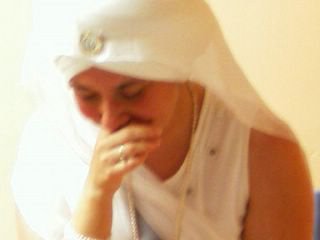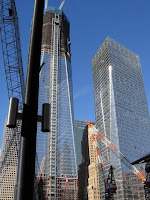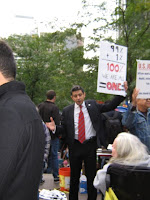Time. It’s a funny thing.
Sometimes in the hustle and bustle of our electronic world,
where every message can be instantly communicated around the world with a touch
of a button, we forget that we live in an organic, creative reality. A seed has
all of the knowledge to become a great and mighty tree. But a seed is not the
tree. It is a potential that has to unfold day by day, month by month, year by
year. What we call time and space, that the physicists attempt to understand with their mathematical formulas, has another name: maturity.
Not only does everything in life have the opportunity to
mature, creation demands it. And this necessity of maturity is equally true
when translating the writings of the Sikh Gurus.
Back in 2007, a dear friend of mine thought she was going to
get married. She asked me to translate Guru Ram Das’s Laavaan for her wedding,
and so I did. I was never completely happy with the translation. It never crystallized. Coincidentally, my friend’s relationship did
not work out, either, and she ended up not getting married.
Five years later, my friend finally found her one and only.
And I went back to the drawing board to revise the translation of the Laavaan.
Maturity. It comes from one simple thing. Through time and space, we
learn. And the more we learn, the more we see life differently.
Something
matured in her life. She got married this last Sunday. And something matured in
me. When I went back to the Laavaan, it was like another door had opened and I could see a dimension that I hadn't seen before.
Since I posted the old version of the
Laavaan from 2007 on my blog, I thought it only appropriate to share what I hope is a more “mature” version with
you.
Enjoy.
With Divine Light,
Ek Ong Kaar Kaur
Guru
Ram Das’s Laavaan Siri
Guru Granth Sahib, Ang 773
First Round
Oh Divine Essence in
all things,
In the first round of
the marriage ceremony,
I become strong in my
commitment
To preserve the grace of
family life and do the work I am called to do,
As I offer myself to
the One who creates
The balance and dance
Between the sun and
the moon.
From the Divine,
subtle vibration of the Creator
Come these sacred
instructions:
Be strong in your
Dharma –
And live a
compassionate truthful life.
I renounce all those
habits
Which harm myself or
cause pain to others,
As I offer myself to
the One who creates
The balance and dance
Between the sun and
the moon.
Be strong in your
Dharma.
Meditate upon the
authentic, creative, Divine Potential
In every identity,
Including your own.
I am completely
committed
To the identity the
Divine has given me
As the sacred
instructions tell me to be.
Rely upon the Sound of
Wisdom
That takes you to
truth.
It is the completely
perfect
Guide and Teacher.
I destroy all those
habits of mind that are negative,
That cause harm to
myself and to others.
Flowing with the flow
of life,
Acting from the bliss
of my own spirit,
By amazing good luck,
I focus my mind
On the ever-present
sweetness of the Divine Essence.
Servant Naanak says,
The first round of the
marriage ceremony
Initiates me into the
work
That I came here to
do.
Second Round
Oh Divine Essence in
all things,
In the second round of
the marriage ceremony,
I am united with my
Protector,
The Sound of Wisdom
that takes me to truth,
As I offer myself to
the One who creates
The balance and dance
Between the sun and
the moon.
The fearful mind
becomes fearless.
And I shed the filth
of my ego.
As I offer myself to
the One who creates
The balance and dance
Between the sun and
the moon.
Singing about the
virtues of the Divine Essence,
I become pure and
deeply respectful.
Directly perceiving
the Divine,
I come into the
presence of the One
Who balances the sun
and the moon.
The Creative, Divine
Self expands because of that One.
The Master resides,
complete and full, in the whole Creation.
Within and without,
Embrace the one
Supreme Lord
Whose essence dwells
in all.
The servants of the
Divine
Sing with delight.
Servant Naanak,
As I walk this second
round of the marriage ceremony,
The silent, subtle
music of self-awakening resounds.
Third Round
Oh Divine Essence in
all things,
In the third round of
the marriage ceremony,
My mind becomes filled
with light and love
When it lives without
attachment to the world.
I offer myself to the
One who creates
The balance and dance
Between the sun and
the moon.
Those servants who
live by their purity, grace and discipline
Merge with the Divine
Essence in all things.
By rare good fortune,
I obtain the experience
Of my inner Divinity,
As I offer myself to
the One who creates
The balance and dance
Between the sun and
the moon.
I attain purity
through the Divine Essence,
And sing about the
virtues and qualities of Divinity.
What my mouth speaks
matches
The vibration and
frequency of Infinity.
Those pure, graceful
and disciplined servants
Who, through
tremendous good fortune,
Have obtained the
Divine Essence
Tell the story that is
Beyond Telling.
The melody of the
Divine
Is born and grows in
me.
An incredible destiny
has been recorded on my forehead,
Oh Beloved One.
I continuously call on
the Divine in all things.
Servant Naanak says,
In this third round of
the marriage ceremony,
The Divine Essence has
taken root
So that the mind may
live unattached to the world.
Fourth Round
Oh Divine Essence in
all things,
In the fourth round of
the marriage ceremony,
My mind surrenders to
the harmonious flow of the universe
By experiencing the
seed of Divinity within me and within all.
I offer myself to the
One who creates
The balance and dance
Between the sun and
the moon.
Aligning myself to the
Guru’s teachings,
I merge easily into
that Divine Essence.
A sweetness overtakes
my body and mind,
As I offer myself to
the One who creates
The balance and dance
Between the sun and
the moon.
The sweetness of my
inner Divinity
Overtakes me.
I become pleasing to
my Creator Lord.
Night and day,
I live attuned to my
love
Of the Divine.
The mind, filled with
longing,
Receives its reward,
And the Master of
Creation
Causes the Divine
Identity within
To play the music of
Infinity
Expansively.
The One Creative
Consciousness
Which expresses Itself
as both
Inner-Divinity and
Master of Everything
Fashions this work.
The wife’s heart is so
happy
With who she Truly Is.
Servant Naanak says,
in the fourth round of the marriage ceremony,
My Inner- Divinity
obtains union
With the Invincible
and Undying Creator Lord.
(Poetically
interpreted by Ek Ong Kaar Kaur Khalsa. Copyright. April 2012.)

















